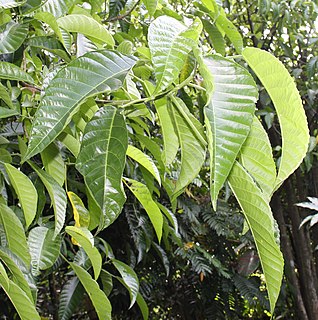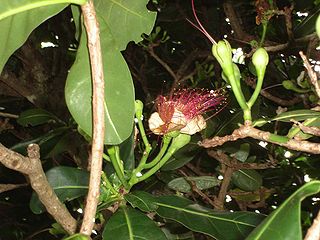
Alyxia is an Australasian genus of flowering plant in the dogbane family, Apocynaceae. It contains at present 106 species, but Alyxia stellata and A. tisserantii are very variable, might be cryptic species complexes, and are need of further study. It consists of shrubby, climbing or scrambling plants. This genus occurs in China, the Himalayas, Southeast Asia, Malaysia, Australia, New Caledonia and the Pacific Islands. There are 14 species in Australia, 21 in New Caledonia and 7 in the other Pacific Islands, including Hawaiʻi.

Antidesma is a genus of tropical plant in the family Phyllanthaceae formally described by Linnaeus in 1753. It is native to tropical Africa, S + E + SE Asia, Australia, and various oceanic islands. The greatest diversity occurs in Southeast Asia.

Endospermum is a genus of plants, under the family Euphorbiaceae and the monotypic subtribe Endosperminae first described as a genus in 1861 They are dioecious, rarely monoecious trees. It is native to E + S + SE Asia, Papuasia, Queensland, and certain islands of the W Pacific.

Homalanthus is a plant genus of the family Euphorbiaceae first described as a genus in 1824. It is the only genus in subtribe Carumbiinae. The genus is native to tropical Asia, Australia, and various islands in the Pacific.

Breynia is a plant genus in the family Phyllanthaceae, first described in 1776. It is native to Southeast Asia, China, the Indian Subcontinent, Papuasia, Australia, and the island of Réunion.

Tristaniopsis is a group of shrub and tree in the myrtle family Myrtaceae described as a genus in 1863. They have a wide distribution in Southeast Asia, New Guinea, New Caledonia and Australia.

Dendrocnide is a genus of approximately 40 species of plants in the nettle family Urticaceae. They have a wide distribution across North East India, Southeast Asia, Australia and the Pacific Islands. In Australia they are commonly known as stinging trees.

Daphniphyllum is the sole genus in the flowering plant family Daphniphyllaceae and was described as a genus in 1826. The genus includes evergreen shrubs and trees mainly native to east and southeast Asia, but also found in the Indian Subcontinent and New Guinea.

Pothos is a genus of flowering plants in the family Araceae. It is native to China, the Indian Subcontinent, Australia, New Guinea, Southeast Asia, and various islands of the Pacific and Indian Oceans.

Barringtonia is a genus of flowering plants in the family Lecythidaceae first described as a genus with this name in 1775. It is native to Africa, southern Asia, Australia, and various islands of the Pacific and Indian Oceans. The genus name commemorates Daines Barrington.

Ochrosia is a genus of flowering plants, first described in 1789. It is in the family Apocynaceae, native to Southeast Asia, Australia, and various islands of the Indian and Pacific Oceans.
- Ochrosia ackeringae(Teijsm. & Binn.) Miq. – Indonesia, Philippines, Papuasia, Christmas Island
- Ochrosia acuminataTrimen ex Valeton - Sulawesi
- Ochrosia alyxioidesGuillaumin - Vanuatu
- Ochrosia apoensisElmer - Luzon, Mindanao
- Ochrosia balansae(Guillaumin) Baill. ex Guillaumin - New Caledonia
- Ochrosia basistaminaHendrian - Sulawesi
- Ochrosia bodenheimarumGuillaumin - Vallée de la Toutouta in New Caledonia
- Ochrosia borbonicaJ.F.Gmel. – Mauritius + Réunion; naturalized in Guangdong
- Ochrosia brevitubaBoiteau - New Caledonia
- Ochrosia brownii(Fosberg & Sachet) Lorence & Butaud - Nuku Hiva in Marquesas
- Ochrosia citrodoraK.Schum. & Lauterb. - New Guinea
- Ochrosia coccinea(Teijsm. & Binn.) Miq. - Maluku, Sulawesi, New Guinea, Solomon Islands; naturalized in Guangdong
- Ochrosia comptaK.Schum., Hōlei – Hawaii
- Ochrosia ellipticaLabill. – Lord Howe Island, Queensland, New Caledonia, Vanuatu, Nauru; naturalized in Guangdong + Taiwan
- Ochrosia fatuhivensisFosberg & Sachet – Fatu Hiva in Marquesas but extinct
- Ochrosia ficifolia(S.Moore) Markgr. - New Guinea
- Ochrosia glomerata(Blume) F.Muell. - Borneo, Sulawesi, Philippines, Maluku, New Guinea, Solomon Islands
- Ochrosia grandifloraBoit. – New Caledonia
- Ochrosia haleakalaeH.St.John, Hōlei – Maui + island of Hawaiʻi in Hawaiian Islands
- Ochrosia hexandraKoidz. - Kazan-retto
- Ochrosia inventorumL.Allorge – New Caledonia
- Ochrosia iwasakiana(Koidz.) Koidz. ex Masam.
- Ochrosia kauaiensisH.St.John, Hōlei – Kauaʻi in Hawaiian Islands
- †Ochrosia kilaueaensisH.St.John, Hōlei – island of Hawaiʻi in Hawaiian Islands, but extinct
- Ochrosia kilneriF.Muell. - Queensland
- Ochrosia lifuanaGuillaumin - Loyalty Islands + Isle of Pines in New Caledonia
- Ochrosia mariannensisA.DC. - Mariana Islands
- Ochrosia mianaBaill. ex Guillaumin – New Caledonia
- Ochrosia minima(Markgr.) Fosberg & Boiteau – Queensland, Papua New Guinea
- Ochrosia moorei(F.Muell.) F.Muell. ex Benth. – Queensland, New South Wales
- Ochrosia mulsantiiMontrouz. – New Caledonia
- Ochrosia nakaiana(Koidz.) Koidz. ex H.Hara - Ogasawara-shoto
- Ochrosia newellianaF.M.Bailey – Queensland
- Ochrosia novocaledonicaDäniker – New Caledonia
- Ochrosia oppositifolia(Lam.) K.Schum. - Seychelles, Chagos Islands, Sri Lanka, Maldive Islands, Andaman & Nicobar Islands, Thailand, Vietnam, W Malaysia, Indonesia, Papuasia, Samoa, Tonga, Tuvalu, Vanuatu, Wallis & Futuna, French Polynesia, Line Islands, Micronesia
- Ochrosia poweriF.M.Bailey - Queensland, New South Wales
- Ochrosia sciadophyllaMarkgr - Bismarck Archipelago, Solomon Islands
- Ochrosia sevenetiiBoiteau - New Guinea
- Ochrosia silvaticaDäniker – New Caledonia
- Ochrosia solomonensis(Merr. & L.M.Perry) Fosberg & Boiteau - Solomon Islands
- Ochrosia syncarpaMarkgr. - Bali, Lombok, Timor, Flores
- Ochrosia tahitensisLaness. ex Pichon – Tahiti
- Ochrosia tenimberensisMarkgr. - Tanimbar Islands
- Ochrosia nukuhivensisFosberg & Sachet = Rauvolfia nukuhivensis(Fosberg & Sachet) Lorence & Butaud
- Ochrosia sandwicensisA.DC. = Rauvolfia sandwicensisA.DC.
- Ochrosia tuberculata(Vahl) Pichon = Rauvolfia sandwicensisA.DC.

Parsonsia is a genus of woody vines in the family Apocynaceae. Species occur throughout Indomalaya, Australasia and Melanesia.

Rhodomyrtus is a group of shrubs and trees in the family Myrtaceae described as a genus in 1841. The genus is native to southern China, the Indian Subcontinent, Southeast Asia, Melanesia, and Australia.

Peristylus, sometimes commonly known as ogre orchids or bog orchids is a genus of flowering plants from the orchid family, Orchidaceae. It consists of over 100 known species found across much of eastern and southern Asia as well as in Australia and on many islands of the Indian and Pacific Oceans.

Sciaphila is a genus of mycoheterotrophic plants in the family Triuridaceae. These plants receive nutrition from fungi and neighboring trees and have less need for photosynthesis. It is widespread in tropical and subtropical regions, found in Africa, China, Japan, the Indian Subcontinent, Southeast Asia, Latin America and on various islands Pacific Islands.

Rhodamnia is a group of rainforest trees and shrubs in the myrtle family described as a genus in 1822. They are native to southern China, Southeast Asia, Papuasia, Australia, and New Caledonia.

Gymnostoma is a genus of about eighteen species of trees and shrubs, constituting one of the four genera of the plant family Casuarinaceae. The species grow naturally in the tropics, including at high altitudes having temperate climates, in forests in the region of the western Pacific ocean and Malesia. In New Caledonia, published botanical science describes eight species found growing naturally, which botanists have not found anywhere else (endemics). Additional species have been found across Burma, Sumatra, Borneo, the Philippines, Sulawesi, Ambon Island, the Moluccas, New Guinea, the Bismarck Archipelago, the Solomon Islands, and one endemic species each in Fiji and the Wet Tropics of Queensland, Australia.

Phrynium is a plant genus native to China, India, Southeast Asia, New Guinea and Melanesia. It was described as a genus in 1797.

Decaspermum is a genus of the botanical family Myrtaceae, first described as a genus in 1776. It is native to China, Southeast Asia, Queensland, and various islands of the Pacific Ocean.
Octamyrtus is a group of plants in the myrtle family Myrtaceae described as a genus in 1922. It is native to New Guinea and to the nearby Indonesian Province of Maluku.
- Octamyrtus arfakensisKaneh. & Hatus. ex C.T.White - West New Guinea
- Octamyrtus behrmanniiDiels - New Guinea
- Octamyrtus glomerataKaneh. & Hatus. ex C.T.White - New Guinea
- Octamyrtus halmaherensisCraven & Sunarti - Halmahera
- Octamyrtus insignisDiels - New Guinea
- Octamyrtus pleiopetalaDiels - New Guinea, Aru Islands


















